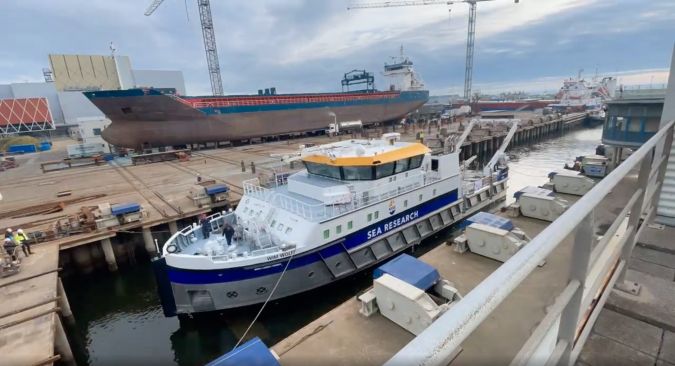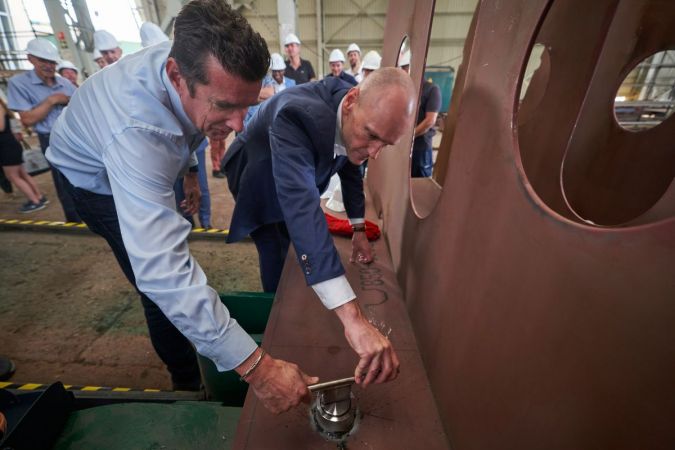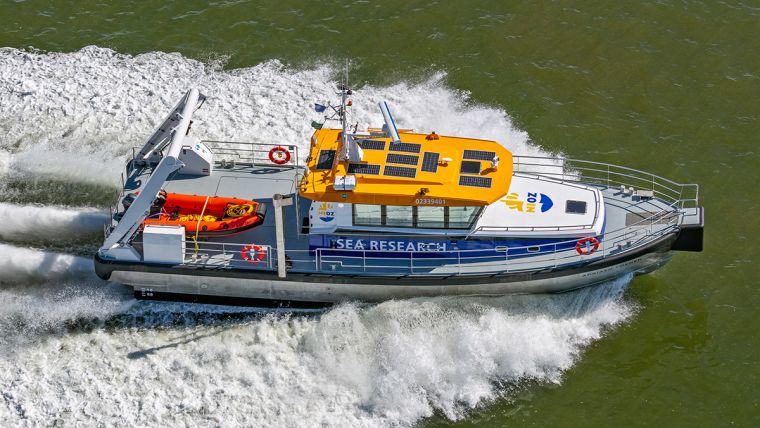The renewal of a research vessel fleet
Redefining oceanic exploration in Dutch marine science
When contemplating the replacement of a research and survey fleet, a collective effort is required to meticulously curate an optimal new fleet, considering factors such as ship type, size, capabilities and flexibility for equipment interchangeability. The flagship, often the largest seagoing research vessel, receives special attention. In this article, the Royal Netherlands Institute for Sea Research (NIOZ), which is actively involved in such an operation, provides valuable insights into its decision-making processes and experiences. This is of significance to the entire Dutch marine scientific community and maritime sector, and can provide help in formulating a comprehensive set of requirements for a new fleet. The formidable costs underscore the gravity of this endeavour, necessitating a careful and strategic approach.
The marine research and maritime sectors of the Netherlands are among the international top. To maintain this position, continued investment in marine scientific knowledge and technological innovation and the replacement of the associated seagoing infrastructure are indispensable. It is for these reasons that a replacement operation involving three research vessels is currently in full swing at the NIOZ, which manages the Dutch national research fleet. The first ship, the RV Adriaen Coenen, was completed in 2022 and work is still underway on replacing the two larger research vessels.
The NIOZ operated three aging research vessels, ranging from approximately 30 to 50 years old. Recognizing the imperative to innovate beyond their economic lifespan, coupled with evolving functional needs, the institute sought a contemporary solution. While research vessels are occasionally refurbished, this proved unfeasible for the trio due to a prior refurbishment and the inherent limitations of repeated renovations. This prompted the pursuit of an entirely new fleet equipped with the latest technology, features and capabilities to meet the evolving demands of marine research.
Next-generation research vessels
The Adriaen Coenen, in use by the NIOZ since 2022, is mainly used for crew and cargo transfers in the Wadden Sea, an intertidal zone located in the south-eastern part of the North Sea. Various research will be conducted with this Wadden ship, ranging from climate change to biodiversity. The Adriaen Coenen is the successor to the 50-year-old RV Stern. The RV Adriaen Coenen is equipped with workplaces for two crew members and 12 passengers, such as scientists, research assistants, students and other passengers. With a shallow draft of just 85 centimetres, the ship is able to pass the tidal flats in the Wadden Sea around high tide and dry up on sandbanks, partly thanks to the use of water jets.
The Wadden Sea research vessel RV Wim Wolff will replace the RV Navicula in 2024. As it will be used for work in the shallow Wadden Sea, it must have a shallow draft. To make the vessel future-proof, high environmental requirements are being imposed on the almost 37-metre-long and approximately 10-metre-wide ship. It meets the sustainability ambitions of NIOZ, which would ideally like to sail emission-free within about ten years. For this reason, the ship is being built with a sustainable diesel-electric power management system that can easily be adapted according to new technological insights and energy sources.

The ocean-going ship Anna Weber-van Bosse is being built at the renowned Astilleros Armon shipyard in Vigo, Spain, after they came out best in the mandatory European tender on price, technical offerings, sustainability, project planning and organization and innovation. Gert-Jan Reichart is closely involved in the building of the Anna Weber-van Bosse. This state-of-the-art vessel will soon be conducting oceanographic research all over the world. Construction started this month (December 2023) and the ship should be delivered in autumn 2025, becoming operational a few months later. Compared to the current RV Pelagia, the RV Anna Weber-van Bosse will have much larger laboratories, more accommodation and more modern equipment.
Choosing the right equipment
While all of the vessels in the new fleet have many innovative and noteworthy features, we pay particular attention here to the flagship, the Anna Weber-van Bosse. This vessel is intricately designed, with a drop keel equipped with a myriad of sensors. The expansive gondola beneath the Anna Weber-van Bosse captures the imagination, as it boasts an array of sensors, including deepwater, ocean-depth and shallow-water multibeam. The drop keel further houses a series of acoustic Doppler current profilers operating at various frequencies, facilitating diverse measurements. Additionally, the vessel incorporates an underwater acoustic positioning system (USBL) in multiple lengths, featuring an extendable pole for flexible usage in both deep and shallow waters and accommodating the distinct frequencies required for various depths.
“We started putting together the equipment for the Anna Weber-van Bosse more than five years ago,” says Gert-Jan Reichart. “This started with consultation rounds at the various universities that will use it, as the ship is a national facility of the Netherlands. The key question that we asked all potential stakeholders was: what do you need? The specifications were drawn up based on this, resulting, among other things, in a foremast with all kinds of equipment for atmospheric measurements and an aft deck that is as large as possible to accommodate all kinds of third-party equipment. In this way, we tried to make the ship as widely applicable as possible.”
Onboard a new-generation research vessel
“We are also working on renewing equipment such as AUVs, ROVs and gliders. There is sufficient space on the new flagship for this type of larger equipment, and that was quite a challenge because, compared to the huge research ships owned by France and Germany, we want to limit our ships to a maximum of 80 metres, to ensure their flexibility in coastal areas as well as the open seas. As a result, we had to build as efficiently as possible,” Reichart explains. “We also work a lot with the container concept. These containers are all designed with a specific purpose, such as measuring traces of oxygen in bottom water or traces of methane in seawater. In fact, they are laboratories that can be changed per expedition, depending on requirements. The ship itself has very few laboratories, but is modular.”
Communication between the crew and researchers engages two distinct systems. One communication system is tailored to the crew and nautical activities, and the other is an internal system dedicated to the scientific team, providing the ability to observe and monitor all pertinent information during expeditions. Development of this system is currently underway for the flagship Anna Weber-van Bosse. Although the precise details are yet to be finalized, it is envisioned as an advanced web-based platform that allows individuals to access data from anywhere. The selection of software, automation and related elements has been deferred until the last moment, due to the rapidly evolving nature of technological developments. This will ensure the incorporation of the latest advancements.

Advanced sensors
When it comes to integration of the hardware, particularly the advanced sensors onboard, the fixed gondola is of great importance. As researchers also want to be able to work in poor conditions, the weather window must be as large as possible in order to conduct the best and most research possible. A good example here is research into currents in the North Atlantic Ocean, as the time when weather conditions are at their worst is the most scientifically relevant. While a lot of work can be conducted with gliders and remote survey methods, you sometimes just have to get out there. Gert-Jan Reichart explains: “That is why we want our new flagship to be very stable, even under extreme weather conditions. We tested all of this extensively at MARIN, the Maritime Research Institute Netherlands. All the fixed measuring equipment is located in the gondola under the ship, such as the multibeam and the drop keel whose equipment can be changed, making it very flexible and versatile. The research vessel is also equipped with thousands of switches to record all kinds of ship behaviour variables. These can be monitored, making it possible to generate the basic data for creating a digital twin of the entire ship. This allows you to optimally map the operation of the ship.”
Weatherproof
Another important consideration is how to take the varying duration of expeditions and, above all, their changing circumstances, into account. Reichart: “The Anna Weber-van Bosse was built with an enormous weather window, taking into account the different climates and associated conditions in which the ship will operate. Another thing that has been carefully considered is the crew capacity: the cabins can be used with both a single (standard) and double occupancy. This means that over 30 scientists can join an expedition, for example if many samples need to be taken. Of course, IMO regulations stipulate a minimum number of crew members.”

Article continues after text box
Additional facts
Dynamic positioning (DP) is built into the latest NIOZ fleet. However, the Anna Weber-van Bosse is equipped with DP2, due to the safety considerations that necessitate extra redundancy for ecological research work near wind farms.
The vessels do not have any real cranes but use A-frames – especially at the back of the research vessel. A-frames are used to take sediment cores, water samples and so on. The aft deck surface has been enlarged to its maximum so that it can be used as efficiently as possible, particularly because of the requirement to accommodate heavy equipment from Germany.
The purchase of additional parts of the new NIOZ fleet, for example AUVs, are all European tenders because they involve Dutch taxpayer’s money. The gliders and AUVs have been purchased, while the tender procedure for the ROV is still ongoing. Updates on this are expected later in 2024.
Niche market
Compared to other countries, the NIOZ will find itself in a very interesting niche when the new Anna Weber-van Bosse is ready. “We want a ship that is complementary to other fleets and other countries. Germany has two very large ships, the Meteor and the Sonne, one in the Atlantic Ocean and the other in the Pacific, which they generally do not leave. This is a completely different way of working, and the Germans plan far in advance, while we try to be more flexible. We are still talking about a year, but that’s quick compared to the Germans, who are planning three to even five years ahead,” Reichart explains. The French have the Atalante and the Marion Dufresne, which are also much larger vessels.
The Netherlands has therefore positioned itself somewhere in between, with a mid-size ship, which represents a niche in the oceanographic research field. While small ships often only conduct coastal research, the Anna Weber-van Bosse will be a mid-size ship that is capable of expeditions in seas such as the North Sea and the Baltic Sea, but also in the open ocean.
Sustainability and climate change
To what extent is sustainability of the new fleet being taken into account? Gert-Jan Reichart points out that the Anna Weber-van Bosse is built as sustainably as possible, with the cradle-to-cradle concept in mind: “We cannot sail fully electric, but the biggest research vessel will be equipped with a large battery pack suitable for peak shaving. We are trying to prepare the ship for the transition to methanol, so that as soon as this becomes available and is realistic, the ship can be converted. Of course, the ultimate aim is green methanol.”
Critical for Dutch researchers is the ability to sustainably advance their investigative pursuits. This encapsulates the necessity of Dutch investment in a new research fleet, to ensure that researchers can continue their work in an environmentally conscious manner. The NIOZ leads this initiative, managing state-of-the-art equipment tailored for the national marine research community. Through these efforts, a foundation is being laid for continuous scientific exploration and a commitment to sustainability in marine research practices.

Vessel availability
A new fleet of research vessels is a major leap, but how do you ensure that they are used optimally? The fleet is managed by the National Marine Facility, a division of the NIOZ with a vessel committee that examines fleet deployment. The ships are available to anyone in the Netherlands who conducts peer-reviewed research funded by the EU or the Dutch Research Council (NWO), of which the NIOZ is part. The NWO funds the vessels and checks whether there are researchers who need to use them. Via the Marine Facilities Planning website (marinefacilitiesplanning.com), researchers can see where the ships are, what they have worked on and future planning. Requests for particular expeditions can also be made on the website. The Marine Facilities Planning platform is a joint NIOZ, NERC and Maas Software Engineering project that could be made available to other organizations.
Dos and don’ts
What are the dos and don’ts when purchasing a new research vessel? “One do is absolutely to involve as many people and organizations as possible who can contribute their valuable knowledge and skills,” says Reichart decisively. “Approach this as broadly as possible: geologists, biologists, physical oceanographers and so on. All of these scientists with their different perspectives have jointly contributed to our package of requirements. This gives you the widest possible multipurpose ship. In other words, don’t decide for yourself what you think is best for the people who will work with the new fleet, but organize this very explicitly in broad consultation. In fact, it is a beautiful thing: the process of defining your flagship together.”
Reichart continues: “We also involved the crew of the previous flagship, the RV Palagia, as they will work and live on the new vessel for the next 20 years. Crew members often focus on completely different things, which is very valuable. We looked at how to maximize flexibility, with as many sensors as possible, but for the crew, the people who work on the ship, it is of course very important that it is a home.
“It’s crucial to exercise caution and avoid prolonging the process excessively. This is essential to mitigate the risk of falling behind amid evolving realities and emerging technologies, which might lead to your ship becoming outdated,” advises Reichart. He suggests: “Don’t commit to all kinds of technologies at the very beginning of the replacement process, but save that for later when the project is in its final phase. A good example is the large screens for the planning table: you only need to purchase these a few months before delivery. After all, you don’t want systems that are already becoming outdated when you first set sail!”

Conclusion
In a quest to modernize its aging research fleet, the NIOZ is spearheading a meticulous replacement operation, prioritizing factors such as ship type, size and equipment flexibility. Its flagship, the Anna Weber-van Bosse, stands out with innovative features such as a drop keel with advanced sensors and a modular design for diverse research needs. Sustainability is a core focus, aiming for a cradle-to-cradle concept and future adaptability to green methanol. The fleet’s management by the National Marine Facility ensures widespread accessibility for peer-reviewed research, embodying a collaborative, multidisciplinary approach in crafting vessels that cater to scientists’ diverse needs. However, a cautionary note emphasizes the importance of avoiding prolonged decision-making to stay ahead of technological advancements.
RV Anna Weber-van Bosse: features and specifications |
| General |
| 30t stern A-frame, 150 degrees |
| 25t side A-frame |
| DP2 |
| Dyneema coring cable, 8km |
| Dyneema opto-electrical-mechanical cable, 9km |
| Heave compensated winches |
| U-shape anti-rolling tank |
| 30m piston coring |
| Containerhold for 4 x 20' container labs |
| D-deck 20' container labs, 15 positions |
| Deck hangar |
| Living lab |
| 3 x 40' living lab container positions |
| - Energy system (e.g. H2) |
| - Wind-assisted propulsion |
| High-bandwidth satellite connection |
| Hi-res motion sensors |
| Open data equipment |
| Acoustics |
| Low underwater radiated noise |
| Minimal bubble sweep down |
| Drop keel |
| USBL pole |
| Shallow water multibeam |
| Deepwater multibeam, 0.5° x 1°, up to 8km depth |
| Hydrographic singlebeam echosounder, full ocean depth |
| Sub-bottom profiler, full ocean depth |
| USBL: deep and shallow/wide angle |
| Wideband splitbeam scientific echosounder |

Value staying current with hydrography?
Stay on the map with our expertly curated newsletters.
We provide educational insights, industry updates, and inspiring stories from the world of hydrography to help you learn, grow, and navigate your field with confidence. Don't miss out - subscribe today and ensure you're always informed, educated, and inspired by the latest in hydrographic technology and research.
Choose your newsletter(s)
























